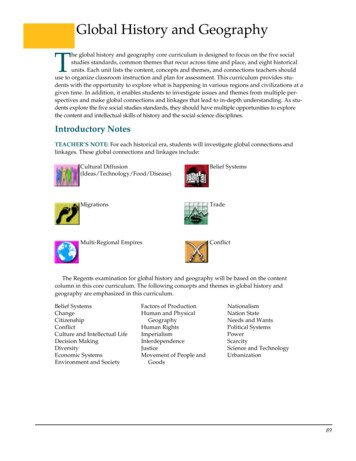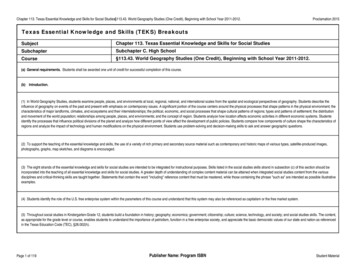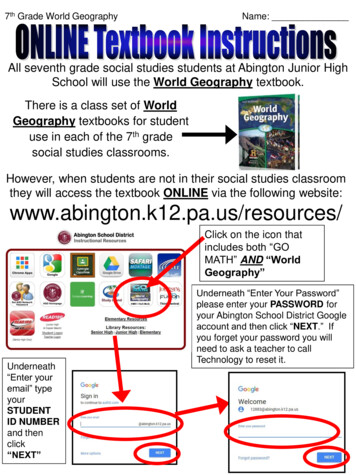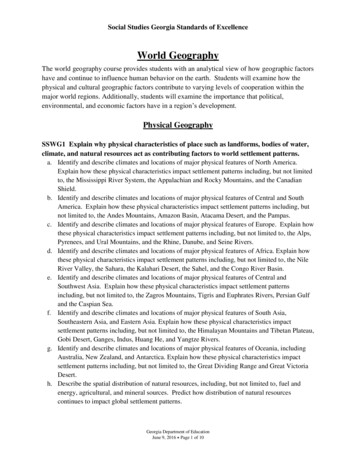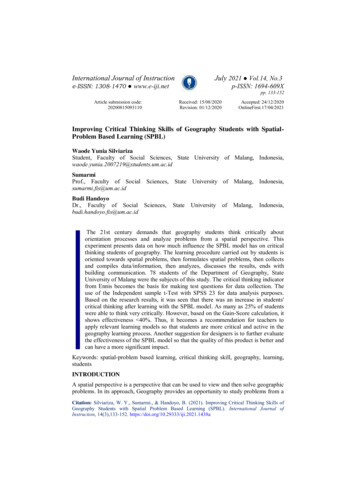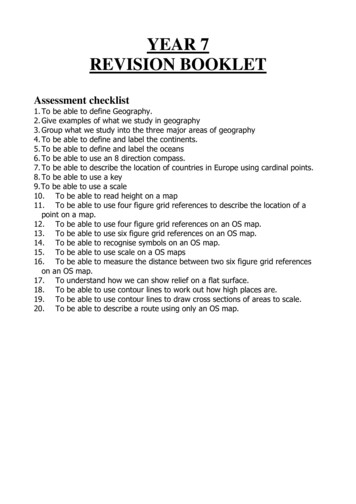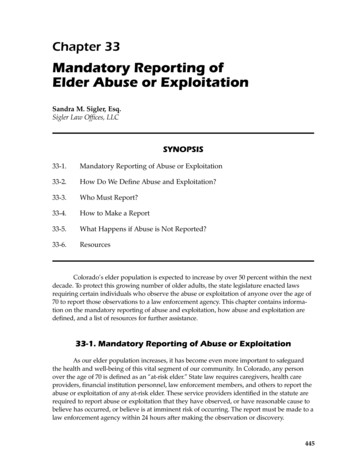
Transcription
GeoJournalAs you read this chapter, use your journalto record similarities and differences inthe ways people live in each of these threeareas: Australia, Oceania, and Antarctica. Useclear and concise language to note interesting details about the region.Chapter Overview Visit the Glencoe WorldGeography Web site at geography.glencoe.comand click on Chapter Overviews—Chapter 33to preview information about the culturalgeography of the region.
Guide to ReadingConsider What You KnowWhat images have you seen in thenews or in films of the various peoples living in Australia, Oceania, andAntarctica? What geographic factorsmight account for the ways peoplelive in each of these areas?Reading StrategyTaking Notes As you read aboutthe population patterns of theregion, use the major headings ofthe section to create an outline similar to the one below.I. Human CharacteristicsA.B.C.II. LanguagesRead to Find Out What peoples settled in Australiaand Oceania? How does the region’s geographyaffect population density, distribution, and growth? What factors account for settlement in urban and rural areas?PopulationPatternsA Geographic ViewDream JourneyLying back and looking at thenight sky, I felt pulled upwardinto that shimmering immensity. . . .Laserlike, a shooting star cutsthe sky . . . and you suddenlyunderstand how the Aborigines,who slept out here beneaththese same stars for 50,000years before the [Europeans]came, could devise their wonderful mythologies of the SkyHeroes who came down fromthe stars in that mystic Dreamtime and shaped the landscape.Rock formations nearLake Argyle, Australia—Harvey Arden, “Journey Into Dreamtime,”National Geographic, January 1991Terms to Know Strine pidgin EnglishPlaces to Locate Kiribati Sydney MelbourneThe Aborigines, Australia’s earliest people, feel adirect relationship to the landscape that has shaped their movementsthroughout the island continent. Physical geography also has influenced migration and settlement patterns of other peoples in Australiaand Oceania. In this section you will learn why Australia and Oceania have diverse cultures and what geographic factors influencewhere their populations live. You will also visit Antarctica, the cold,icy continent at the bottom of the world.Human CharacteristicsAustralia and Oceania have populations with diverse ancestries—indigenous, European, and Asian. Both physical geography and themigration patterns of peoples have shaped the region’s cultures.Coastal scene,Papua New GuineaChapter 33811
the arts ofAUSTRALIARock Art The artistic tradition forwhich Australia’s Aborigines are bestknown is rock art. Rock paintings androck engravings, or petroglyphs, havediverse patterns and subject matterand may date from over 40,000 yearsago. In addition to stylized shapesand symbols, petroglyphs showedhuman faces and bodies. Huntingscenes and animals also oftenappeared in rock art. The meaningsof most of these paintings and petroglyphs, however, remain unknown.Aborigines and MaoriAustralia’s Aborigines may have the oldest surviving culture in the world. The name given to themby European settlers is from the Latin ab origine,meaning “from the beginning.” The first Aboriginesprobably arrived in Australia 40,000 to 60,000 yearsago from Southeast Asia. They lived as nomadichunters and gatherers in small kinship groups alongthe temperate coasts, in the northern rain forests,and across the vast interior deserts. Over the centuries, the Aborigines successfully learned to dealwith the challenges posed by these environments.Today, Aborigines number about 315,000, makingup about 2 percent of Australia’s population.New Zealand’s indigenous peoples, known as theMaori (MOWR ee), came from the Pacific islands ofPolynesia. In New Zealand they hunted, fished,established villages, and raised crops. Many ancientMaori traditions still remain a part of Maori life. Forexample, Maori communities hold festive gatherings called hui in which important local events such812Unit 11as weddings, funerals, and the dedication of newbuildings are celebrated. As a result of intermarriagewith European settlers over the years, most Maoripeople today have at least some European ancestry.Pacific IslandersThe islands of Oceania were probably first settled by peoples from Asia more than 30,000 yearsago. Waves of migrants from Asia continued toarrive over many centuries, while groups alreadyliving in the Pacific area moved from island toisland. Today many different peoples speakinghundreds of languages live on Oceania’s scatteredislands. However, there are three major indigenous groups—Melanesians, Micronesians, andPolynesians—based on the island cluster on whicheach group lives. People on all three island clustersgenerally support themselves by fishing or farming.The first cluster is Melanesia, located in thesouthwestern Pacific Ocean. It includes independent island countries, such as Papua New Guinea,Fiji, and the Solomon Islands, as well as Frenchruled New Caledonia. Melanesian cultures differgreatly, even among groups living in differentparts of the same island.Next is Micronesia, situated in the westernPacific east of the Philippines. Among theindependent countries of Micronesia are theFederated States of Micronesia, Nauru, andKiribati (KIHR uh BAH tee). The area alsoincludes the United States island territories ofGuam and the Marianas. Micronesians also haveseveral different languages and cultures.The last cluster is Polynesia, located in thecentral Pacific area. Three independent countries—Samoa, Tonga, and Tuvalu—are found in Polynesia.Other island groups, known as French Polynesia,are under French rule and include Tahiti, Polynesia’slargest island. Most Polynesians share similar languages and cultures.EuropeansFrom the 1500s to the late 1700s, Europeans sailedthe waters around Australia, New Zealand, andOceania. They set up trading settlements and eventually colonized the region. Europeans, mainly ofBritish descent, still make up most of the populationsof both Australia and New Zealand. Smaller numbers of European groups live on various Pacific
islands. For example, the French-ruled islands ofTahiti and New Caledonia are home to many people of European descent.high percentage of the region’s land is unsuited forhuman habitation. Thus, the region has only onehalf of one percent of the world’s population.AsiansPopulation DistributionAsian communities also exist in the SouthPacific area. Chinese traders and South Asianworkers settled parts of Oceania during the1800s, and today their descendants are includedin the populations of places such as French Polynesia and Fiji. From the early 1900s to 1945,Japan ruled a number of Pacific islands, althoughfew people of Japanese descent live there today.Australia and New Zealand once blocked nonEuropean immigration, but the need for moreworkers finally led to more open immigrationpolicies after the 1970s. Since then, increasingnumbers of East Asians and Southeast Asianshave migrated to Australia and New Zealand insearch of economic opportunity.Because of uninhabitable land and vast differences in physical features and climates, populationin Australia and Oceania is unevenly distributed.Australia is the region’s most heavily populatedcountry. About two-thirds of the South Pacificarea’s 31 million people live in Australia, whichhas almost 90 percent of the region’s habitableland. Very few people, however, live in Australia’sdry central plateaus and deserts. Most live alongthe southeastern, eastern, and southwesterncoasts, which have a mild climate, fertile soil,and access to sea transportation. Most of NewZealand’s people also live in coastal areas.LanguagesBefore the era of modern transportation andadvanced communications, mountains, deserts,and ocean separated the peoples of the SouthPacific area. As a result, isolated groups developedmany different languages. Of the world’s 3,000languages, 1,200 are spoken today in Oceaniaalone, some by only a few hundred people.European colonization brought European languages to the region. Today French is widely spoken in areas of Oceania that remain under Frenchcontrol. English is the major language of Australiaand New Zealand. Australian English, calledStrine, has a unique vocabulary made up of Aboriginal words, terms used by early settlers, andslang created by modern Australians. For example, Australians today call a barbecue a “barbie,”and greet each other with the phrase “G’day.”In many areas of Oceania, varieties of pidginEnglish, a blend of English and an indigenous language, developed to allow better communicationamong different groups.Where People LiveAustralia, Oceania, and Antarctica span a vastarea; Australia and Oceania together cover about5.7 percent of the earth’s land surface. However, aGRAPHSTUDYEthnic Groups of AustraliaCaucasian(White)94%Asian4%Aboriginal andOther2%Source: World Almanac, 20011. Interpreting Graphs What percentage ofAustralians trace their ancestry to Asia?2. Applying Geography Skills Why has thenumber of Asian immigrants in Australiaincreased since the 1970s?Chapter 33813
Population DensityDiversePeoples The South Pacific region is home bothto this indigenous man from Papua New Guinea(inset) and these children of European descent fromAustralia.Place Where are the South Pacific’s most urbanized areas located?Like population distribution, population density varies throughout the region. In Australia, forexample, the population density averages only7 people per square mile (3 per sq. km). In someinterior rural areas, a person can travel 100 miles(161 km) without seeing another human being. Incoastal urban areas, however, population densityis much higher. Australia’s urban areas are hometo 85 percent of the country’s total population.Like many developed countries, Australia has anaging population and a declining birthrate. YetAustralia’s population probably will continue toincrease because of immigration.Oceania’s population is growing at an average rate of 2.3 percent per year because it has arelatively young population. The land area ofOceania’s 25,000 islands totals only 551,059square miles (1,427,246 sq. km), and the population density varies greatly. Because Papua NewGuinea has a large area, its population densityis only 28 people per square mile (11 per sq. km).Tiny Nauru, measuring just 9 square miles (23 sq.km), has the highest population density in Oceania—about 1,111 people per square mile (435 per sq. km).In spite of its small area, mining of the island’s richphosphate deposits provides jobs and funding foreconomic development.UrbanizationIn Oceania, the population is divided unequallyamong the island countries. Papua New Guinealeads with about 5 million people, whereasNauru—the world’s smallest republic—has a population of only 10,000. Many more Pacific islanderslive on their countries’ coasts than in the oftenrugged interiors.Antarctica’s forbidding, icy terrain and mercilesspolar climate have never supported permanenthuman settlement. Conditions are difficult for allbut short-term stays by research scientists andadventurous tourists. Although Antarctica measuresabout 5.5 million square miles (14.2 million sq. km),most research stations cluster along the AntarcticPeninsula, where summer temperatures may rise toa relatively mild 32ºF (0ºC). During this season thepopulation of research stations reaches about 10,000,but only about 1,000 people remain during winter.814Unit 11Most people in Australia and New Zealand livein cities or towns along the temperate coasts.The largest Australian cities are Sydney andMelbourne—each with more than 3 million residents. Sydney, located on the eastern coast, andMelbourne, on the southern coast, are port cities andcommercial centers. Other coastal urban areas inAustralia are Brisbane, Adelaide, and Perth. Fewpeople, on the other hand, live in the hot, dry climateof Australia’s interior.New Zealand’s ports of Auckland, Christchurch,and Wellington are Oceania’s largest cities. Theseand other cities in the region offer newcomers opportunities for a high standard of living, quality healthcare, and excellent education.Urban areas in Australia and Oceania draw people from within their own countries as well as fromother countries. In Australia internal migration has
led to shifts in population distribution. During the1990s the population in rural areas declined whilethat of large cities and their suburbs grew rapidly.A similar pattern can be seen in Oceania, where 70percent of the population lives in urban areas.GovernmentImmigrationRapid expansion of industry after World War IIdrew many immigrants to Australia. At first mostimmigrants came from European countries, suchas the United Kingdom, Greece, Yugoslavia, andthe Netherlands. In the 1980s Australia’s industries still needed more workers, so the Australiangovernment created programs to attract people from other regions. Today immigrants comefrom South Africa and various parts of Asia andLatin America. A number of them also come fromOceania. Population growth and uneven economic development in the various Pacific islandscause many young people and skilled workers toseek work elsewhere.Student Web Activity Visit the Glencoe World GeographyWeb site at geography.glencoe.com and click on Student WebActivities—Chapter 33 for an activity about immigration andcultural diversity in Australia.Publicly funded programs provide travel assistance to immigrants and help them adjust toAustralian society. Most immigrant workers settlein major industrialized cities because of highpaying jobs. Today about 26 percent of Australia’spopulation is foreign born. One worker fromLebanon describes his experience to a journalist:“In this one factory you had people frommaybe ten, twelve different countries,all speaking different languages. That’swhat Sydney was like. . . . It’s a beautiful . . . country—beautiful. Greatweather. Lovely lifestyle. Plenty of opportunity if you want to work hard.”Bill Bryson, “Sydney,”National Geographic,August 2000Throughout Australia and Oceania, meeting theneeds of a growing multiethnic population is amajor concern. Diversity enriches the region’s languages, arts, music, and lifestyles. At times, however, this same diversity may cause disagreementsover issues such as immigration, health benefits,employment, and the effects of colonial rule. Thenext section highlights the legacy of the past andhow it shapes life in Australia and Oceania today.Antarctica, with no permanent population, has ahistory that is unique to that icy continent.Checking for UnderstandingCritical ThinkingAnalyzing Maps1. Define Strine, pidgin English.3. Categorizing Information From6. Region Study the population2. Main Ideas On a chart like theone below, fill in three mainideas from the section and thenlist important supporting detailsfor each idea.Main IdeasSupporting Detailswhat areas have peoples migratedto Australia and Oceania?4. Identifying Cause and EffectWhat geographic factors causemost of Australia’s population tocluster in coastal urban areas?5. Predicting Consequences Whatare possible positive and negativeeffects as modern technology andtransportation attract more people to the South Pacific region?density map on page 786.What are the most sparselypopulated areas of the SouthPacific region?Applying Geography7. Movement and PopulationCreate two maps, one ofmigration patterns during thelast 100 years, and the othershowing population distribution in the region today.Chapter 33815
Guide to ReadingConsider What You KnowVarious indigenous peoples livedin Australia and Oceania beforethe Europeans established coloniesthere. What indigenous groups invarious parts of the world have youread about or seen in movies or ontelevision?Reading StrategyOrganizing Complete a web diagramsimilar to the one below by filling inthe hardships the Maori faced afterBritish settlement in New Zealand.Maori HardshipsRead to Find Out What were the lifestyles of theregion’s indigenous peoplesbefore colonization? How did colonial rule affect social,economic, and political structures? How do today’s governmentsreflect the region’s history?History andGovernmentA Geographic ViewPacific OriginsSamoa itself is said to mean “sacredcenter”. . . . [T]his is where the worldbegan as the creator, Tagaloalagi, firstcalled forth earth, sea, and sky fromrock. . . . Language links and artifacts suggest that the first distinctlyPolynesian culture may have developed here some 3,000 years ago.Over the centuries that followed,seafarers in double-hulled sailingvessels stocked with pigs, dogs,and fruits spread that cultureacross much of the Pacific.Samoan diverin Pacific waters—Douglas Chadwick, “The Samoan Way,”National Geographic, July 2000Terms to Know clan boomerang trust territory dominionPlaces to Locate Vanuatu TongaEuropean and American influences in the pastthree centuries have profoundly changed the indigenous peoples andcultures of the South Pacific area. In this section you will learn aboutthe early inhabitants of Australia and Oceania, the effects of Westernsettlement and rule in these areas, and the emergence of independentcountries and new governments during the past 100 years.Indigenous PeoplesHistorians, anthropologists, archaeologists, and other scientists arecontinually uncovering new information about the history of earlySouth Pacific peoples. At the same time, after years of Western dominance, indigenous peoples throughout the region are rediscoveringtheir historical roots and are renewing their traditional cultures. Allof these developments have heightened global interest in and appreciation of the South Pacific’s pre-European past.816Unit 11
music ofAUSTRALIAThe oldest music in Australia is that of the Aborigines.Music has always played a central role in both socialand sacred life. Much of the traditional music inthis region is based on vocals, though windand percussion instruments arealso very important.Instrument SpotlightIn its traditional form, the didgeridoo (DIH juh ree DOO)was made by nature when a eucalyptus branch fell to theground and was hollowed out by termites. The Aboriginesconsidered it sacred and continue to make it an importantpart of their spiritual ceremonies. Didgeridoos have becomepopular outside Australia and are manufactured and playedall over the world. Through a combination of lip, tongue,and mouth movements, a wide variety of interestingsounds can be produced from this simple instrument.World Music: A Cultural Legacy Hear music of this region on Disc 2, Tracks 25–29.Early MigrationsVarious peoples from Asia settled the region ofAustralia and Oceania more than 40,000 years ago.Some may have migrated to Australia over landbridges during the Ice Age, when ocean levels weremuch lower than they are today. Others probablyused canoes and rafts to reach the South Pacificregion. The reason they came to these areas is a mystery. Because of their connection to the sea, some ofthese peoples, especially those who came to theSouth Pacific region, may have regarded exploration as a natural part of daily life. Author PeterCrawford, impressed with the daring of these earlyexplorers, described the early Polynesians:“A tenacious, seafaring people had abandoned the shores of [S]outheast Asia andsailed into the Pacific. As their culturedeveloped, they acquired new skills of survival, and new knowledge of the oceanworld which became their home. . . . Thevibrant Polynesian culture that grew andflourished . . . is testament to the invention and adaptability of its people.”Peter Crawford, Nomadsof the Wind: A NaturalHistory of Polynesia, 1993EconomicsIndigenous LifestylesIn the hot, dry Australian interior, the earlyAborigines led a nomadic life. They used welltraveled routes to reach water and seasonal foodsources. These same routes made trading andsocial exchanges possible. Clans, or familygroups, traveled together within their ancestralterritories, carrying only baskets, bowls, spears,and sticks for digging. To hunt animals, Aboriginal men used a heavy throwing stick, called aboomerang, that soars or curves in flight, and thewomen and children gathered plants and seeds.In Oceania people settled in family groups alongisland coasts. For food they relied on fish, turtles,Chapter 33817
MAP STUDYAustralia and Oceania: Colonies, 1900140 E160 E180 TROPIC OF Caroline IslandsPalauIslandsGilbertIslandsNauruGermanNew GuineaPapuaTROPIC OF CAPRICORN140 WHawaiianIslandsPalmyraIslands20 NChristmasIslandPhoenixOceanIslandsIslandSolomon ElliceCookTokelauIslands sFiji Is.TahitiFriendlyNewCaledoniaIslandsA u s t r a l i aEQUATOR0 MarquesasIslandsTuamotuArchipelago20 , 1900BritishFrenchU.S.German160 WMidwayIslandsINTERNATIONAL DATE LINE120 EPacificOceanNewZealand40 S0 mi.Tasmania1. Interpreting Maps What two countries ruledthe area of Samoa?1,5000 km1,500Miller Cylindrical projection2. Applying Geography Skills Why do you thinkthe United States took over Guam?Find NGS online map resources @ www.nationalgeographic.com/mapsand shrimp as well as breadfruit and coconuts.Pacific islanders also cultivated root crops, such astaro and yams, and raised smaller animals, such aschickens and pigs. Well-built canoes made lengthyvoyages possible, and trade gradually developedamong the islands. To make trading easier, peopleon some islands used long strings of shell pieces asmoney. Today in New Britain, an island off thenortheast coast of Papua New Guinea, shellmoney still is exchanged for canned goods or vegetables at markets.Increased trade was accompanied by migrationsamong the islands. Between the A.D. 900s and 1300s,the Maori people left eastern Polynesia and settled818Unit 11the islands of New Zealand. On New Zealand’sNorth Island and South Island, Maori groupshunted, fished, established villages, and farmed theland. Maori farmers, like the Pacific islanders, grewroot crops, such as taro and yams, which they hadbrought from their Polynesian homeland.European ColonizationFrom the 1500s to the 1700s, Europeans of variousnationalities explored vast stretches of the SouthPacific region. Perhaps the most well-known explorerwas the British sailor James Cook, who undertook three voyages to the region between 1768 and
1779. Cook claimed eastern Australia for GreatBritain, visited various South Pacific islands, circledAntarctica, and produced remarkably accuraterecords and maps of these places.European SettlementGreat Britain at first used Australia as a colonyfor convicts sent out from overcrowded Britishprisons. The first shipload of prisoners arrived atBotany Bay, in what is today Sydney, in 1788. Bythe early 1850s, the imprisonment of British convicts in Australia had ended, and growing numbersof free British settlers were establishing coastalfarms and settlements. Livestock, especially sheep,were introduced to the continent. As British textilemanufacturers increased their demand for wool,Australian settlers profited greatly from exporting wool to the parent country. Another source ofwealth for Australia was gold, which was discovered there in the early 1850s. The resulting goldrush nearly tripled Australia’s population in 10years and also promoted the mining of other mineral resources in the continent’s interior.Meanwhile, the British and other Europeans werealso establishing settlements in Oceania. Attractedby excellent fishing waters and rich soil, British settlers arrived in New Zealand in the early 1800s.They brought with them sheep, cattle, and horses.By the end of the century, raising livestock hadbecome a major part of New Zealand’s economy. Onsome South Pacific islands, European businesspeople set up commercial plantations for growingsugarcane, pineapples, and other tropical products.Indigenous PeoplesThe arrival of Europeans in Australia andOceania had a disastrous impact on indigenouspeoples. As British migrants spread acrossAustralia, they forcibly removed the Aboriginesfrom the land and denied them basic rights.Many Aborigines resisted the European advance,but European diseases and weapons steadilyreduced the Aboriginal population. In the mid1800s, British-Australian authorities placed manyAborigines in reserves, or separate areas.British settlement in New Zealand brought hardships to the Maori, who died from diseases carriedby the newcomers. The Maori social structure alsowas weakened when the British colonists introduced new ways of farming and other aspects ofEuropean culture. As the number of European settlers increased, the British and some Maori chiefssigned a treaty in 1840 that guaranteed the Maorifull rights under the British monarchy. Disagreements about the treaty, however, led to armed Maoriresistance to British rule over the next 15 years. During these conflicts, many Maori were killed, and theMaori gradually lost most of their land to the British.The Europeans also brought far-reaching changesto the other peoples of Oceania. Because Europeandiseases had reduced indigenous island populations,the Europeans brought in workers from other Pacificislands and from more distant areas, such as SouthAsia. The resulting mix of cultures weakened indigenous societies and eventually led to ethnic conflicts.Meanwhile, Europeans sought to replace traditionalways of life with European beliefs and practices.Struggle for PowerDuring the late 1800s and early 1900s, Britain,France, Germany, Spain, and the United States struggled for control of various Pacific islands. Many ofthese countries already had commercial interests inthe area. The Europeans hoped to expand their influence and gain new sources of raw materials.The two World Wars changed the course ofOceania’s history. After World War I, many ofGermany’s Pacific colonies came under Japaneserule. Then in December 1941, Japanese airplanesbombed the United States Naval Base at PearlHarbor in Hawaii. This attack brought the UnitedStates into World War II. During the conflict theUnited States and Japan fought a number of fiercebattles on Pacific islands such as Guadalcanal andIwo Jima.Following Japan’s defeat in World War II, Japan’sSouth Pacific possessions, such as the islands ofMicronesia, were turned over to the United Statesas trust territories. Trust territories were dependent areas that the United Nations placed underthe temporary control of a foreign country. Sincethe 1970s most of these islands, including Palau,the Marshall Islands, and the Federated States ofMicronesia, have become independent countries.Independent GovernmentsIndependence came to most of the South Pacificregion during the 1900s. Australia and New ZealandChapter 33819
became the region’s first independent countries inthe early 1900s. By the century’s end, most of thePacific islands had gained independence.Australia and New ZealandAustralia and New Zealand both peacefully wontheir independence from British rule. In 1901Britain’s Australian colonies became states, unitedto form the Commonwealth of Australia. The newAustralian country was a dominion, a largely selfgoverning country within the British Empire.Australia’s form of government blended a UnitedStates-style federal system with a British-styleparliamentary democracy. The British monarch—represented by a governor general—served asAustralia’s head of state, but a prime ministeractually headed the national government.In 1907 New Zealand became a self-governingdominion with a British parliamentary system.New Zealanders, however, contributed some political “firsts” of their own. In 1893 New Zealandbecame the first country in the world to legallyrecognize women’s right to vote. New Zealandalso was among the first countries to provide government assistance to the elderly, the sick, and theunemployed.Until World War II, New Zealand and Australiamaintained close economic, military, and politicalties to Great Britain, now known as the UnitedKingdom. After 1945 British global influencedeclined, and the two Pacific countries lookedincreasingly to the United States for trade andmilitary protection. In addition, Australia andNew Zealand developed their own national characters based on increasingly diverse populations.The Aborigines and the Maori won greater recognition of their unique cultural identities, andmany non-British immigrants settled in bothcountries. Many Australians now want to cut tiesto the British monarchy and elect a president. In2002, terrorist attacks on the Indonesian island ofBali shattered Australia’s sense of security. Morethan a third of the nearly 200 people killed wereAustralians.South Pacific IslandsPromoting Culture An indigenous group inPapua New Guinea perform traditional ceremonialdances.Place When did most countries in Oceania gaintheir independence?Beginning in the 1960s, anumber of the small islands inOceania moved toward independence. Samoa—formerlyWestern Samoa—had beenruled by Germany until NewZealand assumed control afterWorld War I. In 1962 Samoabecame the first Pacific islandterritory to win its freedom.Today most of the SouthPacific islands enjoy someform of independent government. For example, Vanuatu,once jointly governed by theUnited Kingdom and France,is a republic, and Tonga, formerly under British protection,is a constitutional monarchy.Some island countries, such asFiji and the Solomon Islands, have been torn by ethnic conflict since independence. Many conflictshave roots in colonial times, when European rulersbrought in foreign workers from other cultures,ignoring traditional ethnic and cultural patterns.
AntarcticaEuropeans first sighted Antarctica during theearly 1800s, but they believed that the icy continent had little, if any, commercial value. As aresult, expeditions did not venture into Antarcticauntil much later. In the early 1900s, Norwegianexplorer Roald Amundsen and British explorerRobert Scott, each with a team of four peopl
Chapter OverviewVisit the Glencoe World Geography Web site at geography.glencoe.com and click on Chapter Overviews—Chapter 33 to preview information about the cultural geography of the region. Population Patterns A Ge
